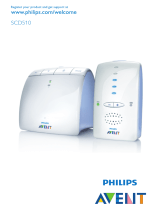
4 5
A
B
C
D
C
H
A
N
N
E
L
SYSTEM CHECK
O
P
E
N
-
S
E
N
S
I
T
I
V
I
T
Y
+
4
3
5
-
S
E
N
S
I
T
I
V
I
T
Y
+
4
3
5
ENGLISHENGLISH
Features explanation
Avoiding interference
If there is interference or if sound reception is poor, switch both units to
another channel.
Always make sure that the channel selection switches on both units are set
to the same position.
Checking that the units are in touch
Check that the SYSTEM CHECK light on the Parent unit lights
continuously (green) to confirm that the connection between both units
is reliable.
If the light flashes (red), move the Parent unit closer to the Baby unit.
The light flashes if the units are out of range for more than 30 seconds or
if there is interference.
Switching on the system check alarm
You can switch on the system check alarm on the Parent unit that beeps
when the units are not in touch. The Parent unit is delivered with the
system check alarm switched off.
Open the Parent unit’s battery compartment cover.
Set the switch inside compartment to the ON position (
).
Close battery compartment cover.
The SYSTEM CHECK light can still flash even if the system check alarm is
switched off.
Range 250m in open air
The baby monitor has an operating range of up to 250 metres in ideal
open-air conditions. This means that the units can see each other with no
obstacles in between. Walls, ceilings, large objects and even glass affect the
operating range. The more obstacles there are in between, the shorter the
operating range.
1
2
3
Using batteries
Operating the Baby unit cordlessly
Remove the battery compartment cover using a coin.
Insert four 1.5V, LR6 (AA) batteries noting the + and - configuration
inside the battery compartment.
Batteries not included; we recommend non-chargeable Philips Alkaline
batteries.
Put the cover back in place and secure using a coin.
> If the power light flashes (red) install new batteries.
The unit operates for up to 30 hours on batteries.
Operating the Parent unit cordlessly
Remove the battery compartment cover using a coin.
Insert four 1.5V, LR6 (AA) batteries noting the + and - configuration
inside the battery compartment.
Batteries not included; we recommend non-chargeable Philips Alkaline
batteries.
Put the cover back in place and secure using a coin.
> If the power light flashes (red) install new batteries.
The unit operates for up to 30 hours on batteries.
Batteries
Dispose of used batteries in an environmentally friendly manner.
Do not mix old and new batteries, or different types of batteries.
Remove batteries if the baby monitor is not to be used for long periods.
1
2
3
1
2
3
IFU463.p65 17/01/2002, 19:294-5






